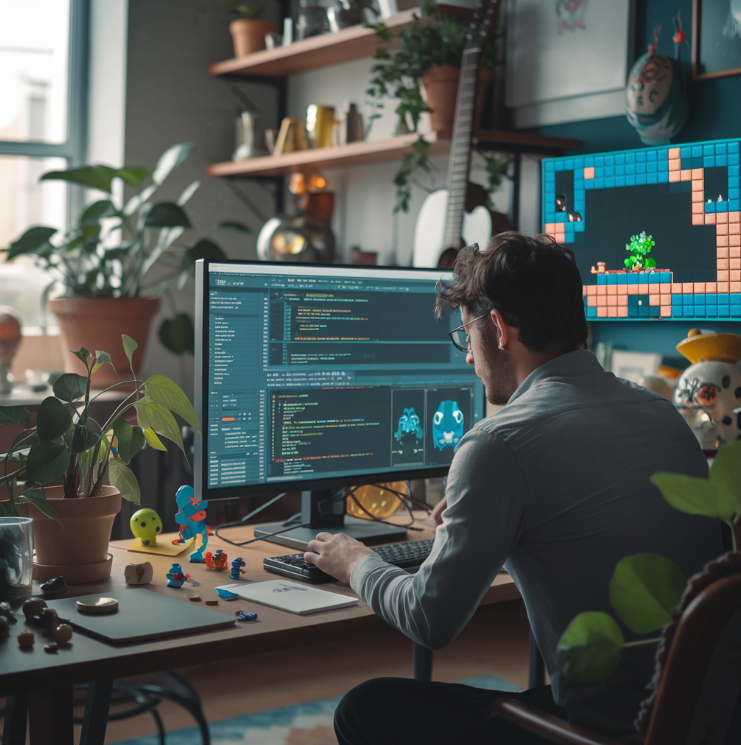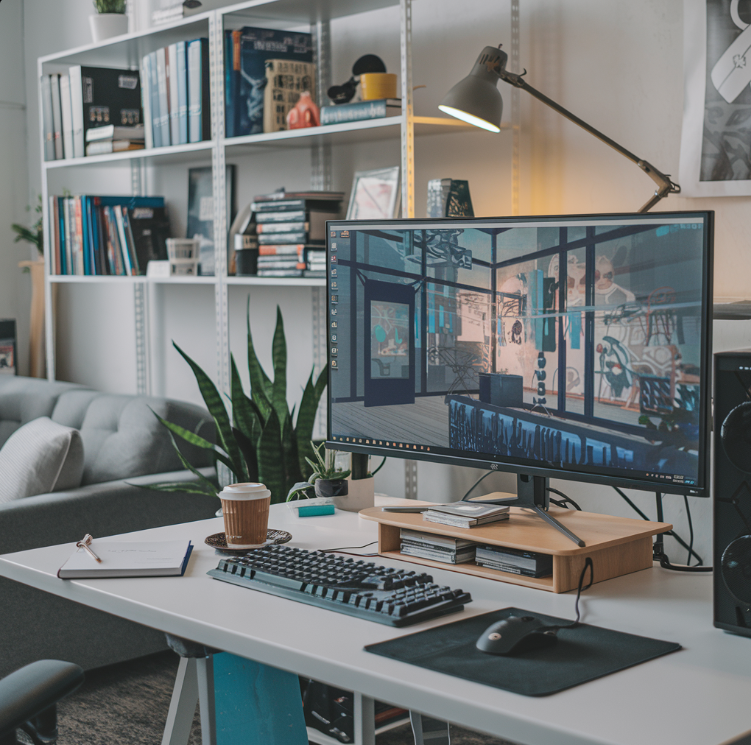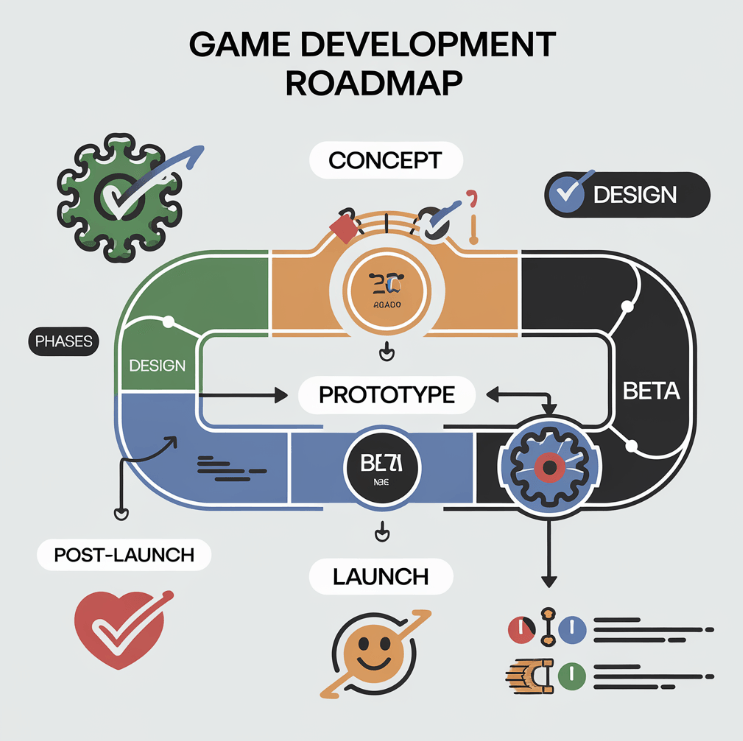Introduction to Game Development
What is Game Development?
Game development is a process in which games are created. Game development has many stages such as designing, programming, testing, and publishing. The main goal of game development is to create an audience that the players will like.
There are so many steps involved in the game development process, such as, the game’s concept being decided, then design and planning being decided. After this the coding of the game is started, then graphics and sound effects are added, and finally after testing the game is released. Each type of game has its own unique requirements, such as the design and user interface of mobile games is different as compared to console games or PC games.
Importance of a Game Development Roadmap
It is very important to have a roadmap in game development because a roadmap is a plan that gives structure to the game development process. If you have a clear roadmap, you will know what work needs to be done at which step and by when. Roadmap makes the development process smooth and time management also becomes easy so that the game can be developed easily.
If you plan for game development, you can use your resources well and avoid unexpected delays. Roadmap also gives better clarity to the team and everyone gets to know about their work so that the team members complete their work efficiently and the project is completed on time.
Key Players in Game Development
Game development is a team effort, and each member has his or her own role defined. Some key players who are involved in game development include game designers, programmers, artists, sound engineers, and quality assurance testers. Everyone has their own responsibility, and all people work together.
The job of a game designer is to decide the concept and mechanics of the game. Programmers work on the coding and functionality of the game. Artists create the game’s visual elements like characters, backgrounds, and animation. Sound engineers create the game’s music and sound effects. Testers identify the bugs and glitches of the game and ensure that the game runs smoothly or there are no problems in the game or the user gets a good experience.
It is important to have multiple skills in game development. Everyone’s expertise is different, and these skills help in successfully completing the game. Sometimes in game development or after game development, external partners and stakeholders like publishers and marketers are also involved who help in launching and marketing the game.
Teamwork is very important in game development, because every member tries to give the best performance in his work. With a roadmap, the team is able to manage its tasks efficiently and make the game a quality product.
Identifying Your Target Audience
The first step in game development is to understand your target audience. Meaning, which age group, gender, and location of players is your game designed for? Apart from this, you also need to understand their interests and gaming habits. Understanding all these demographic and psychographical factors helps you decide what type of players your game will attract.
Doing market research is also an important part of this process. You also need to analyze your competitors, like what types of games are being successful in the market, what is their gameplay like, and how is the audience responding to them. Getting feedback from gaming communities is also a good way to get ideas from direct players and learn about their needs and expectations.
Crafting a Compelling Game Idea

Developing a game idea is a creative process. You also have to think about how your game will be unique, and how it will be different from other games available in the market. For this you have to define the Unique Selling Proposition of your game, which makes your game different from other games.
While refining the idea, it is also important that you check whether you have the required resources, time and budget to develop the game? If the idea does not seem practical, you can make some modifications.
Outlining Game Mechanics and Features
Defining game mechanics is an important step in which you have to decide the core elements of the game such as controls, gameplay loop, scoring system, and player progression. At this stage, you have to balance the gameplay, that is, the game should not be too complex and not too easy, so that every level challenges the player or makes the player enjoy the game.
Creating a Project Timeline
It is important to create a solid project timeline in game development. You should set realistic milestones and keep in mind deadlines. It is also important to understand the different phases of the development process, such as planning, development, testing, and launch.
For timeline management, you can use tools like Zoho, or Jira, in which you can track your tasks and ensure that everything is completed on time.
Budgeting and Resource Allocation
An important part of game development is budgeting. You have to estimate expenses related to the development process of your game, such as tools, software, team salaries, and marketing expenses. If you do not check all these, then you can face problems in the future.
It is also important to allocate resources efficiently. You have to decide which employee is best fit for which task. If you have limited employees, it may be important to consider funding strategies such as investors, or loans.
Establishing a Development Workflow

When choosing a development methodology, you have to decide whether your team will follow Agile, Waterfall, or some other approach. Agile approach is more flexible because it focuses on iterative process, whereas Waterfall is a more structured approach.
You can better manage your workflow by using tools for team communication and task management. Version control systems like Git or SVN are also important so you can manage the development process and track changes made by team members.
Building Your Development Prototype
Prototyping is an important phase of game development because with Prototype you can test the basic concept of your game, and take feedback and make improvements. Prototyping helps you refine your game’s core mechanics and gameplay elements.
Designing Game Art and Sound
The art and sound design of the game improves the overall experience of the game. This requires collaboration between artists and developers so that the game’s visual style and audio design match each other.
It is also important to understand the principles of art and sound design such as color theory, animation styles, and soundscapes. By using tools like Photoshop, Blender, and Ableton you can create high quality visual and audio assets.
Implementing Game Mechanics and Systems
Implementing the game’s mechanics and systems is a core part of development. By using programming skills, you code the mechanics of the game and ensure that everything works smoothly.
Quality Assurance and Playtesting
Testing is a crucial step in game development. With quality assurance you ensure that there are no major bugs or issues in the game. Through playtesting you get feedback from real players and refine the game.
Preparing for Launch
To launch you have to prepare a go to market strategy. This includes pre launch, launch, and post launch phases. In pre launch you start marketing and promotion, on the day of launch you distribute the game, and in post launch you have to respond to the feedback of players who have updated your game.
Marketing and Community Building
After the game development is complete, it is important to make a marketing plan for the game. You can promote your game by using social media and online platforms. After the release of the game, it is also important to engage with the player community, so that you can get their feedback and suggestions and improve future updates.
Popular Tech Stack for Game Development
There are different tools are used for game development? First of all, game engines like Unity and Unreal Engine are quite popular, which handle the core development of the game. Programming languages like C#, C++, and Python are used for game development and game mechanics and features. Photoshop, Blender, and Maya are used for graphics and design. Tools like Audacity and Ableton are helpful for sound design. Git and GitHub are used for version control so that team members can easily collaborate. This tech stack provides a solid base for game development.
Also check our other blog post.
What is Artificial General Intelligence in Simple Words (AGI)
Introduction to deep learning with pytorch
Apache Kafka vs Confluent Kafka: A Comprehensive Guide

